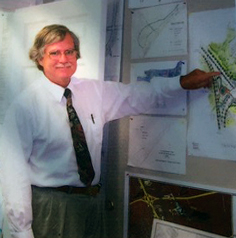Urban Planner and Powerhouse Behind the Market Common
by Melissa LaScaleia
Jack Walker was the oldest of six children, and grew up in Columbia, South Carolina. As a boy, he had a paper route that took him through his neighborhood and beyond, exposing him to a variety of home styles, building materials, and landscapes.
Jack was disheartened by the landscapes and neighborhoods that he saw. The experience inspired a passion in him to pursue urban planning while he was still in his youth, to affect how neighborhoods were shaped and built.
To carry out his vision, he attended Clemson University and graduated with a degree in architecture. For the early part of his career, he focussed on historic preservation in the Columbia area. From there he segued into large-scale municipal planning, which led to him develop a deeper understanding of the interconnectedness between the human and built environment, specifically the importance of greenways in protecting the environment and establishing healthy communities.
Jack spent many childhood vacations with his family in Myrtle Beach. In 1984, he returned to the area on a contract position for the City of Myrtle Beach, and eventually became the first director of planning for the city— trading private sector work for public.
This was just prior to the closure of the Myrtle Beach Air Force Base and the redevelopment years of the ’90s. Jack played a key role during the post closure time frame, which has earned the moniker the “Golden Age” due to the successful collaboration by officials, creation, and initial implementation of wide-scale urban planning for the city, which was projected to occur over the next thirty years.
He played a major role in the redevelopment of the area that is today the Market Common, but his vision extended throughout Myrtle Beach and included new master plans for the downtown area of the city as well as the Myrtle Beach Pavilion area. The state of the economy was an asset for the city’s plans, as many new high-rise hotels and projects were already underway.
Jack served on a number of boards and committees dedicated to the Myrtle Beach Air Force Base redevelopment. He, the Myrtle Beach Air Force Base Redevelopment Authority, and the city, worked closely together to make the project a reality.
First, Jack worked with Design Works, L.C. to create a master plan for the area. Integral to the plan was the creation of housing and job opportunities for the area’s residents. They took into account the existing architecture of the base and tried to preserve, where possible, any buildings and spaces that could be integrated into the new concept with ease.
Jack brought his passion for outdoor urban recreation spaces to the design of the Market Common, implementing paths and trails to facilitate a walking, biking community.
He assisted with the design of Grand Park, and envisioned the Market Common as being a representation of what the future of the rest of Myrtle Beach could look like: a combination of sustainable, local economy, creative and attractive use of land, living spaces, and outdoor recreation opportunities.
He conceptualized Perrin’s Path, a roughly mile-long walking/biking path which runs from 48th Avenue North to 62nd Avenue North. The path, which took ten years to complete, is quiet, wild and woody, connecting those who traverse it with the native flora and fauna which was prevalent everywhere before the city was built.
The path is interactive, with interpretive signs along the way that illustrate birds that frequent the area, and benches made from bug-resistant wood. In time, the big-picture intent is to link it to the East Coast Greenway, a network of trails that connects Maine to Florida.
Jack retired as the city planning director in 2015, but continues to act as a presence and force in our community with his forward-thinking use of urban space.

















